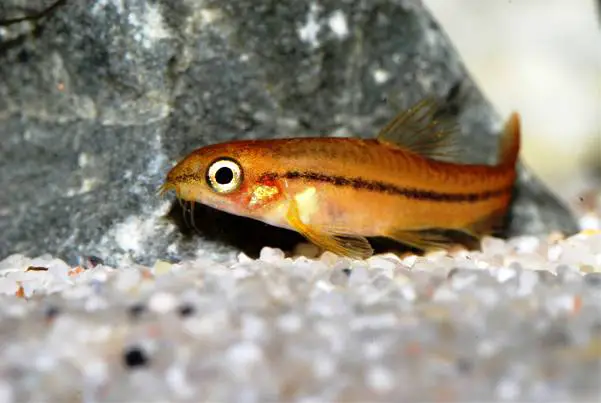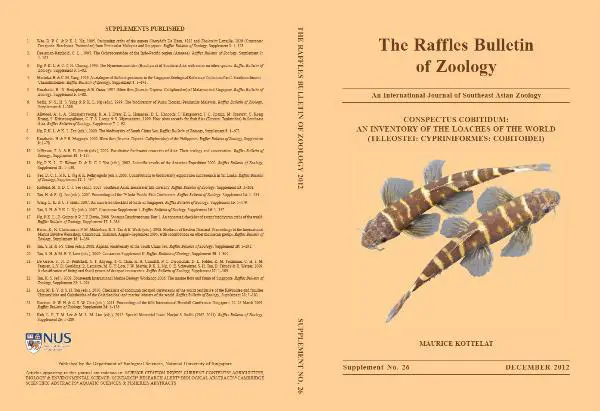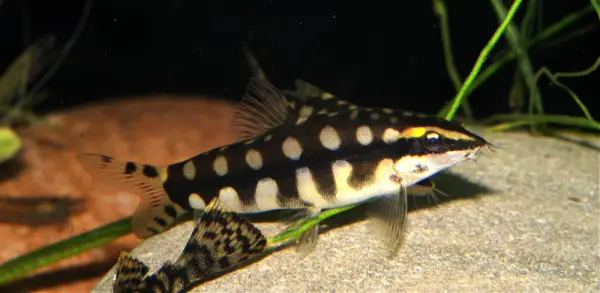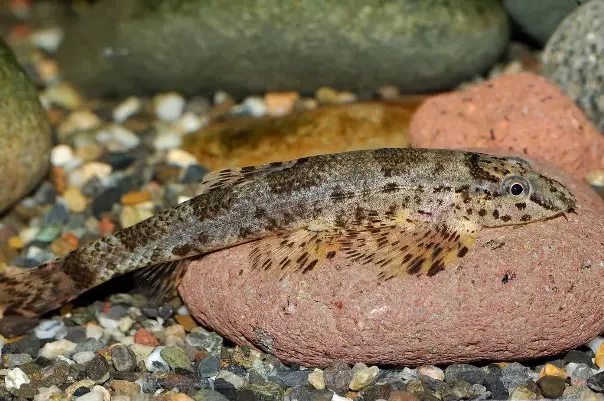Dwarf chain loach reclassified: a summary of recent changes in loach taxonomy
The dwarf chain loach or ‘sid’, formerly Yasuhikotakia sidthimunki, has been assigned to a new genus in one of a number of important alterations to loach taxonomy published in the latest supplement issue of ‘The Raffles Bulletin of Zoology’.
The supplement, an inventory of all known loaches of the world compiled by ichthyologist Maurice Kottelat, contains the descriptions of three new genera and two new families plus a multitude of nomenclatural changes, so we thought it would be useful to provide a summary, concentrating on known aquarium fishes.
Ambastaia, new genus
We begin with the change that will undoubtedly evoke the most groans in the aquarium world. This new genus within the family Botiidae contains just two species, A. nigrolineata and A. sidthimunki, which were previously included in both Botia and, more recently, Yasuhikotakia.
Members are diagnosed from other botiids solely on the basis of adult colour pattern and ontogeny, the former comprising a whitish-yellowish background with a black midlateral stripe on each flank and an additional, mid-dorsal stripe, with vertical bars connecting these two stripes and extending onto the lower portion of the body.
This distinguishes them from the genus Yasuhikotakia, within which they were most recently included, because members of that grouping possess a large dark blotch at the base of the caudal-fin and a juvenile colour pattern comprising a series of thin vertical bars on the flanks which tend to fade with age.
In Ambastaia the vertical markings appear later in life and are retained in adults. Moreover, phylogenetic analyses have shown that A. nigrolineata and A. sidthimunki are not even closely-related to Yasuhikotakia spp., instead forming the sister group of the genus Sinibotia.
Barbuccidae, new family
This new assemblage currently contains the single genus Barbucca which itself includes just one described member, B. diabolica, alongside several undescribed species.
Barbuccidae is distinguished from other Cobitoidea families by mouth structure with members possessing a smooth, fleshy upper lip which may or may not have a median notch. The lower lip runs continuous with the upper and is fleshy with a median interruption, and a thick, fleshy barbel-like projection along its posterior edge.
The skin of the throat between the median extremities of the lower lip forms a fleshy, triangular lobe, with a soft, thin, compressed projection orientated perpendicular to body. There are two pairs of rostral barbels and one pair of maxillary barbels withy all barbels possessing rings of small projections. The lower jaw is ‘exposed’.
The other main difference between Barbuccidae and other loach families is the shape of the swim bladder (aka gas bladder) capsule. In Cobitidae this is a single globulous structure, while in Botiidae and Vaillantellidae it’s incompletely formed.
In the families Nemacheilidae, Balitoridae, Gastromyzontidae (Sawada, 1982), Serpenticobitidae (Nalbant, 2001) and Ellopostomatidae the capsule comprises two smaller chambers connected to each other posteriorly and forming a canal referred to as the ‘manubrium’ surrounding the duct which connects the two halves of the anterior swim bladder chamber.
Ellopostomatidae is lsightly different to the others in that the manubrium does not form a complete tube but comprises a bony lamina around the ventral portion of the connective duct, but in Barbuccidae it’s absent entirely and the duct exposed.
Other distinguishing characters for Barbuccidae include: body short, compact, and marked with vertical bars; head small, snout blunt, with large, oval-shaped, dorso-laterally orientated eyes; anterior nostril located at the tip of a short tube; posterior nostril located at base of tube and adjacent to eye orbit; caudal-fin emarginate; dorsal-fin origin slightly anterior to pelvic-fin origin; pectoral and pelvic fins are orientated laterally, and each has only a single simple ray; presence of large tubercles on lower flank above anal-fin (number and distribution variable depending on species).
Serpenticobitidae, new family
This grouping currently comprises the genus Serpenticobitis with three described species which had previously been considered members of the families Cobitidae (Roberts, 1997; Kottelat, 2001), Nemacheilidae (Nalbant, 2002) or Balitoridae (Šlechtová et al., 2007).
Serpenticobitidae is told apart from all other Cobitoidea families by the following combination of characters: body short and cylindrical in shape, with a barred colour pattern; head small, snout rounded and conspicuously overhanging; presence of a large bifid spine below eye; caudal-fin slightly forked; dorsal-fin origin anterior to pelvic-fin origin; pectoral fins oriented laterally; pectoral and pelvic fins with a single simple ray; mouth small and arched; upper and lower lips fleshy and continuous with one another; lower lip with a few folds and a median interruption but no mental lobes; presence of two pairs of rostral barbels and one pair of maxillary barbels; lower jaw partly exposed; anterior nostril pierced at front side of a flap-like tube; all fins containing rows of spots; presence of a large, conspicuous black spot at the caudal-fin base; swim bladder capsule comprises two smaller chambers connectedby a manubrium.
Theriodes and Speonectes, new genera
Two additional new genera are raised in the paper:
Theriodes sandakanensis (Inger & Chin, 1962) is an odd-looking loach which was described in the genus Acanthophthalmus (now considered a synonym of Pangio) and included in Lepidocephalichthys by some recent authors. It’s now the only member of the genus Theriodes and unknown in the ornamental fish trade.
Speonectes also contains just a single species. S. (formerly Sundoreonectes) tiomanensis (Kottelat, 1990) is a cave-dweller known only from a single locality on Tioman Island (off Peninsular Malaysia) and is unlikely to have been maintained in captivity.
Additional changes

Former Yunnanilus species from Myanmar are now grouped within the revalidated genus Petruichthys. © Charles König
There are a number of additional changes in taxonomy, some of which affect popular aquarium fish. These are summarised as follows:
- Yunnanilus brevis and Y. sp. ‘rosy’ are moved to the revalidated genus Petruichthys Menon, 1987 based on the fact that Yunnanilus as previously recognised ‘is very heterogenous’, although no detailed explanation is provided. Yunnanilus species formerly included in the Y. nigromaculata group are now placed in the revalidated genus Eonemacheilus Berg, 1938.
- Yunnanilus cruciatus is transferred to the revalidated, monotypic genus Micronemacheilus Rendahl, 1944 from which it had previously been removed by Frehyof and Serov (2001).
- The family Gastromyzontidae is revalidated and split from the family Balitoridae. It contains the following genera: Annamia, Beaufortia, Erromyzon, Formosania, Gastromyzon, Glaniopsis, Hypergastromyzon, Katibasia, Liniparhomaloptera, Neogastromyzon, Paraprotomyzon, Parhomaloptera, Plesiomyzon, Protomyzon, Pseudogastromyzon, Sewellia, Vanmanenia and Yaoshania.
- The revised Balitoridae thus contains the genera Balitora, Balitoropsis, Bhavania, Cryptotora, Hemimyzon, Homaloptera, Homalopteroides, Homalopterula, Jinshaia, Lepturichthys, Metahomaloptera, Neohomaloptera, Sinogastromyzon and Travancoria.
- Within Balitoridae the genus Homaloptera is split into Homaloptera, Homalopteroides, Homalopterula and Balitoropsis, but see note below.
- The horse-faced loach is now Acantopsis dialuzona van Hasselt, 1823, with A. choirorhynchos (Bleeker, 1854) a junior synonym.
- The genus Paracanthocobitis Grant, 2007 is now referred to as a questionable synonym of Acanthocobitis.
There are also a number of minor nomenclatural corrections, but the final point of interest to aquarists is perhaps that a long-awaited colour photograph of the real ‘kuhli loach’, Pangio kuhli, appears on page 37.
NB: Although Dr. Kottelat suggests the splitting of the genus Homaloptera into Homaloptera, Homalopteroides, Homalopterula and Balitoropsis, we prefer to follow Randall and Page (2012) who revalidated Homalopteroides but retained Homalopterula and Balitoropsis as putative subgenera following phylogenetic analyses, concluding that further study is necessary in order to be certain of their taxonomic status.
Homalopteroides thus appears in our Knowledge Base but all other species are grouped within Homaloptera for the time being. We’re also busy updating all loach species profiles with the new information, a process which should be completed shortly.
For further information download the full, open access paper: Kottelat, M. 2012. Conspectus cobitidum: an inventory of the loaches of the world (Teleostei: Cypriniformes: Cobitoidei). Raffles Bulletin of Zoology Supplement No. 26: 1-199
Category: Uncategorized | Comment »







Product reviewers wanted
Are you still looking for product reviewers?
19th Dec 2024
Product reviewers wanted
Hey! Interesting article!
17th Dec 2024
Responsive design
Hey there! I came across Plinkox Bonus and Promo Codes Online while browsing for ways to make gaming sessions more rewarding. The bonuses listed here ...
7th Dec 2024
Product reviewers wanted
Hey there! I came across Plinkox Bonus and Promo Codes Online while browsing for ways to make gaming sessions more rewarding. The bonuses listed here ...
7th Dec 2024
Product reviewers wanted
https://seriouslyfish.com/author/sophietate
27th Nov 2024